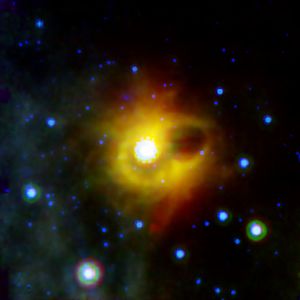Magnetar facts for kids
A magnetar is a type of neutron star with an extremely powerful magnetic field.
Description
Like other neutron stars, magnetars are around 20 kilometres (12 mi) in diameter and have a mass 2–3 times that of the Sun. The density of the interior of a magnetar is such that a tablespoon of its substance would have a mass of over 100 million tons. Magnetars are differentiated from other neutron stars by having even stronger magnetic fields, and rotating comparatively quicker, with most neutron stars completing a rotation once every one to ten seconds, compared to less than one second for a magnetar. This magnetic field gives rise to very strong and characteristic bursts of X-rays and gamma rays. The active life of a magnetar is short. Their strong magnetic fields decay after about 10,000 years, after which activity and strong X-ray emission cease. Given the number of magnetars observable today, one estimate puts the number of inactive magnetars in the Milky Way at 30 million or more.
Starquakes triggered on the surface of the magnetar disturb the magnetic field which encompasses it, often leading to extremely powerful gamma ray flare emissions which have been recorded on Earth in 1979, 1998, and 2004.
Magnetic field
Magnetars are characterized by their extremely powerful magnetic fields of 108 to 1011 tesla. These magnetic fields are hundreds of millions of times stronger than any man-made magnet, and quadrillions of times more powerful than the field surrounding Earth. Earth has a geomagnetic field of 30–60 microteslas, and a neodymium-based, rare-earth magnet has a field of about 1.25 tesla, with a magnetic energy density of 4.0×105 J/m3. A magnetar's 1010 tesla field, by contrast, has an energy density of 4.0×1025 J/m3, with an E/c2 mass density more than 10,000 times that of lead. The magnetic field of a magnetar would be lethal even at a distance of 1000 km due to the strong magnetic field distorting the electron clouds of the subject's constituent atoms, rendering the chemistry of life impossible. At a distance of halfway from Earth to the moon, a magnetar could strip information from the magnetic stripes of all credit cards on Earth. As of 2010[update], they are the most powerful magnetic objects detected throughout the universe.
As described in the February 2003 Scientific American cover story, remarkable things happen within a magnetic field of magnetar strength. "X-ray photons readily split in two or merge. The vacuum itself is polarized, becoming strongly birefringent, like a calcite crystal. Atoms are deformed into long cylinders thinner than the quantum-relativistic de Broglie wavelength of an electron." In a field of about 105 teslas atomic orbitals deform into rod shapes. At 1010 teslas, a hydrogen atom becomes a spindle 200 times narrower than its normal diameter.
Origins of magnetic fields
The strong fields of magnetars are understood as resulting from a magnetohydrodynamic dynamo process in the turbulent, extremely dense conducting fluid that exists before the neutron star settles into its equilibrium configuration. These fields then persist due to persistent currents in a proton-superconductor phase of matter that exists at an intermediate depth within the neutron star (where neutrons predominate by mass). A similar magnetohydrodynamic dynamo process produces even more intense transient fields during coalescence of pairs of neutron stars.
Formation

When in a supernova, a star collapses to a neutron star, and its magnetic field increases dramatically in strength. Halving a linear dimension increases the magnetic field fourfold. Duncan and Thompson calculated that when the spin, temperature and magnetic field of a newly formed neutron star falls into the right ranges, a dynamo mechanism could act, converting heat and rotational energy into magnetic energy and increasing the magnetic field, normally an already enormous 108 teslas, to more than 1011 teslas (or 1015 gauss). The result is a magnetar. It is estimated that about one in ten supernova explosions results in a magnetar rather than a more standard neutron star or pulsar.
Images for kids
-
Artist's conception of a powerful magnetar in a star cluster
-
On 27 December 2004, a burst of gamma rays from SGR 1806−20 passed through the Solar System (artist's conception shown). The burst was so powerful that it had effects on Earth's atmosphere, at a range of about 50,000 light-years.
See also
 In Spanish: Magnetar para niños
In Spanish: Magnetar para niños






